Unit 4 - Leadership & Management: Impact on Operations & Starbucks
VerifiedAdded on 2023/06/18
|7
|1452
|127
Report
AI Summary
This report analyzes the influence of leadership and management on business operations and performance, focusing on Starbucks as a case study. It differentiates between the roles of a leader and a manager, exploring leadership theories such as trait theory, situational leadership, and contingency leadership. The report also discusses management functions, referencing Henri Fayol's five functions (planning, organizing, commanding, coordinating, and controlling) and Mintzberg's management roles. It highlights the differences between leadership and management, emphasizing that leadership focuses on inspiring and motivating individuals, while management involves controlling and monitoring tasks. The report concludes by aligning leadership and management styles with organizational objectives, underscoring their diverse activities and approaches to employees.
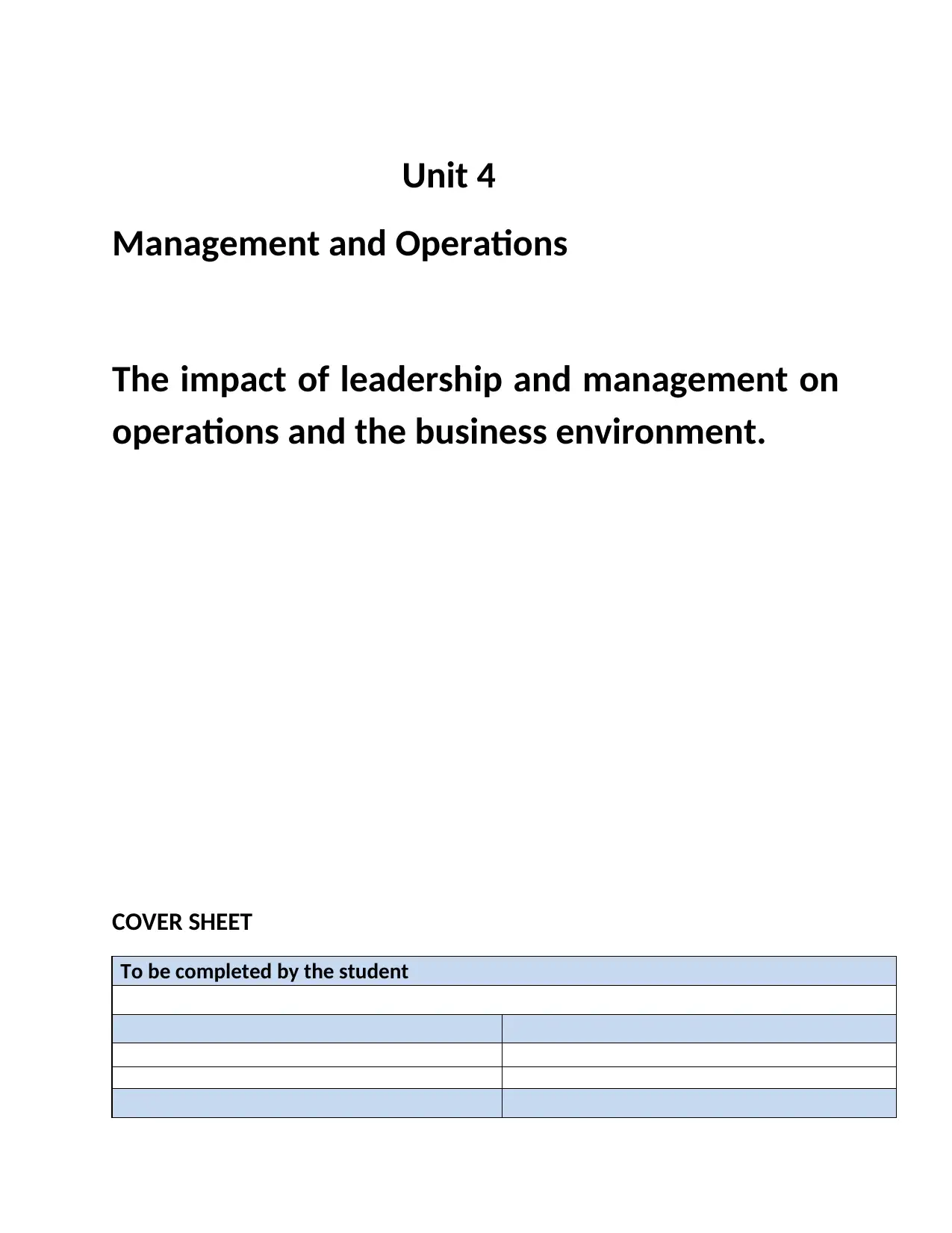
Unit 4
Management and Operations
The impact of leadership and management on
operations and the business environment.
COVER SHEET
To be completed by the student
Management and Operations
The impact of leadership and management on
operations and the business environment.
COVER SHEET
To be completed by the student
Paraphrase This Document
Need a fresh take? Get an instant paraphrase of this document with our AI Paraphraser
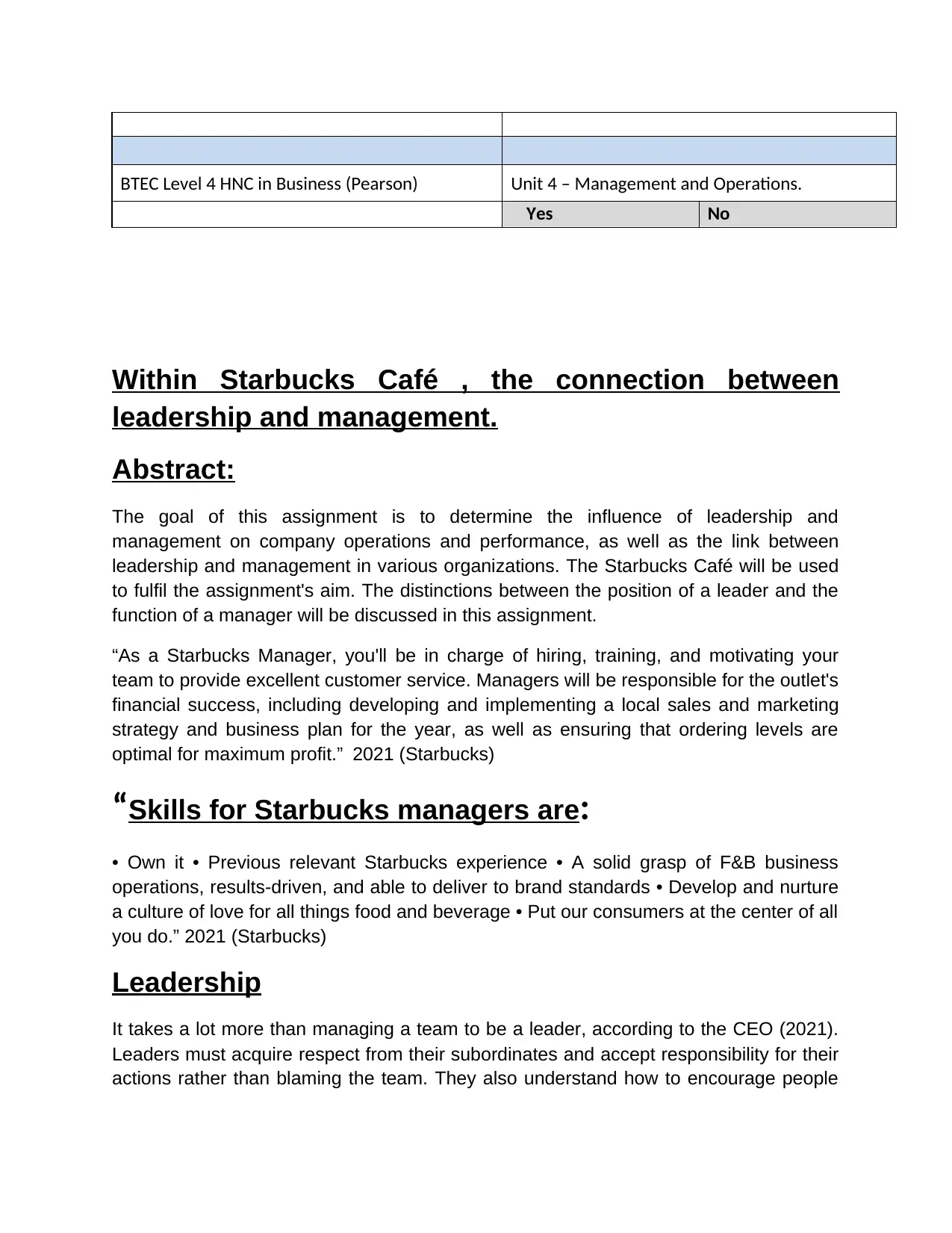
BTEC Level 4 HNC in Business (Pearson) Unit 4 – Management and Operations.
Yes No
Within Starbucks Café , the connection between
leadership and management.
Abstract:
The goal of this assignment is to determine the influence of leadership and
management on company operations and performance, as well as the link between
leadership and management in various organizations. The Starbucks Café will be used
to fulfil the assignment's aim. The distinctions between the position of a leader and the
function of a manager will be discussed in this assignment.
“As a Starbucks Manager, you'll be in charge of hiring, training, and motivating your
team to provide excellent customer service. Managers will be responsible for the outlet's
financial success, including developing and implementing a local sales and marketing
strategy and business plan for the year, as well as ensuring that ordering levels are
optimal for maximum profit.” 2021 (Starbucks)
“Skills for Starbucks managers are:
• Own it • Previous relevant Starbucks experience • A solid grasp of F&B business
operations, results-driven, and able to deliver to brand standards • Develop and nurture
a culture of love for all things food and beverage • Put our consumers at the center of all
you do.” 2021 (Starbucks)
Leadership
It takes a lot more than managing a team to be a leader, according to the CEO (2021).
Leaders must acquire respect from their subordinates and accept responsibility for their
actions rather than blaming the team. They also understand how to encourage people
Yes No
Within Starbucks Café , the connection between
leadership and management.
Abstract:
The goal of this assignment is to determine the influence of leadership and
management on company operations and performance, as well as the link between
leadership and management in various organizations. The Starbucks Café will be used
to fulfil the assignment's aim. The distinctions between the position of a leader and the
function of a manager will be discussed in this assignment.
“As a Starbucks Manager, you'll be in charge of hiring, training, and motivating your
team to provide excellent customer service. Managers will be responsible for the outlet's
financial success, including developing and implementing a local sales and marketing
strategy and business plan for the year, as well as ensuring that ordering levels are
optimal for maximum profit.” 2021 (Starbucks)
“Skills for Starbucks managers are:
• Own it • Previous relevant Starbucks experience • A solid grasp of F&B business
operations, results-driven, and able to deliver to brand standards • Develop and nurture
a culture of love for all things food and beverage • Put our consumers at the center of all
you do.” 2021 (Starbucks)
Leadership
It takes a lot more than managing a team to be a leader, according to the CEO (2021).
Leaders must acquire respect from their subordinates and accept responsibility for their
actions rather than blaming the team. They also understand how to encourage people
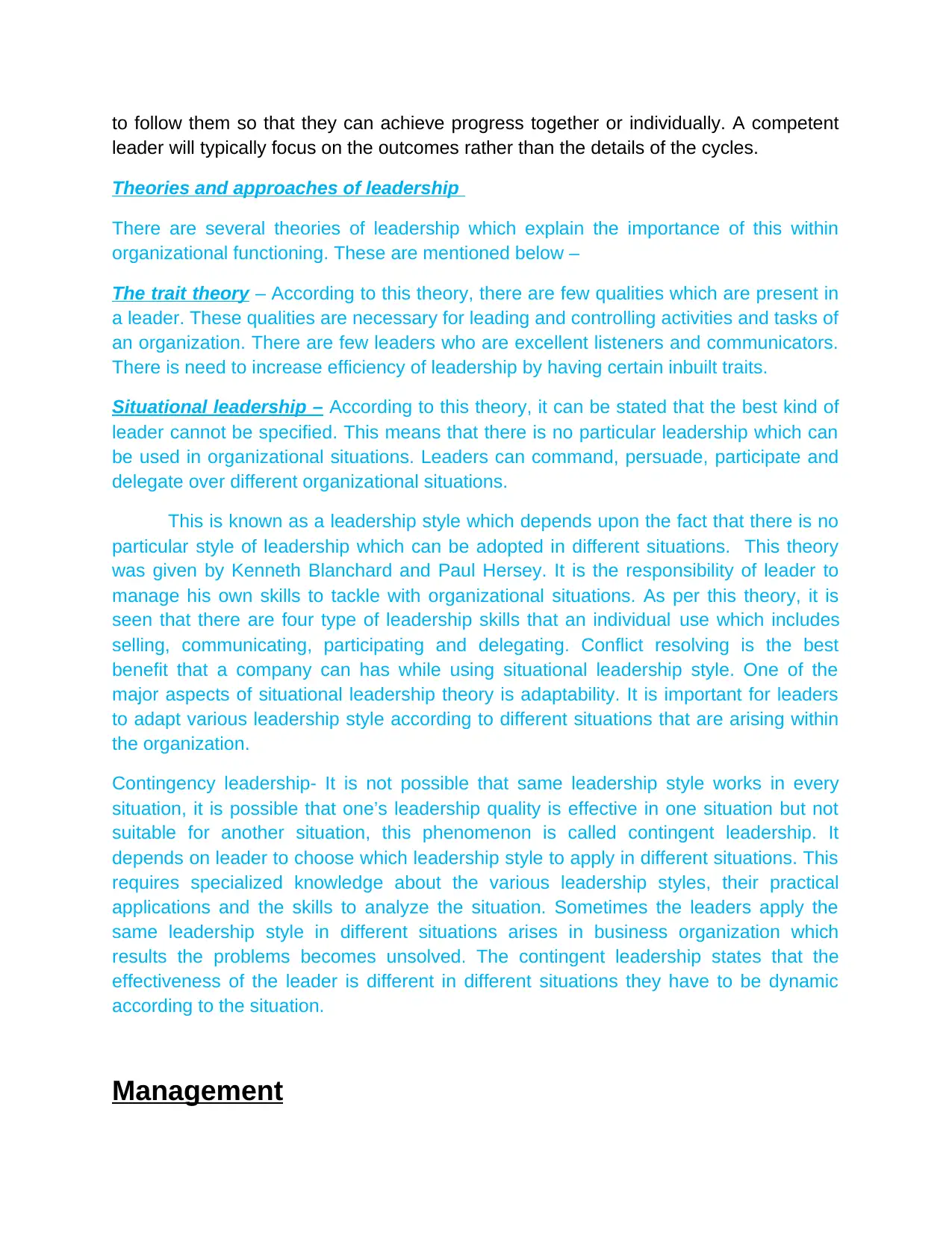
to follow them so that they can achieve progress together or individually. A competent
leader will typically focus on the outcomes rather than the details of the cycles.
Theories and approaches of leadership
There are several theories of leadership which explain the importance of this within
organizational functioning. These are mentioned below –
The trait theory – According to this theory, there are few qualities which are present in
a leader. These qualities are necessary for leading and controlling activities and tasks of
an organization. There are few leaders who are excellent listeners and communicators.
There is need to increase efficiency of leadership by having certain inbuilt traits.
Situational leadership – According to this theory, it can be stated that the best kind of
leader cannot be specified. This means that there is no particular leadership which can
be used in organizational situations. Leaders can command, persuade, participate and
delegate over different organizational situations.
This is known as a leadership style which depends upon the fact that there is no
particular style of leadership which can be adopted in different situations. This theory
was given by Kenneth Blanchard and Paul Hersey. It is the responsibility of leader to
manage his own skills to tackle with organizational situations. As per this theory, it is
seen that there are four type of leadership skills that an individual use which includes
selling, communicating, participating and delegating. Conflict resolving is the best
benefit that a company can has while using situational leadership style. One of the
major aspects of situational leadership theory is adaptability. It is important for leaders
to adapt various leadership style according to different situations that are arising within
the organization.
Contingency leadership- It is not possible that same leadership style works in every
situation, it is possible that one’s leadership quality is effective in one situation but not
suitable for another situation, this phenomenon is called contingent leadership. It
depends on leader to choose which leadership style to apply in different situations. This
requires specialized knowledge about the various leadership styles, their practical
applications and the skills to analyze the situation. Sometimes the leaders apply the
same leadership style in different situations arises in business organization which
results the problems becomes unsolved. The contingent leadership states that the
effectiveness of the leader is different in different situations they have to be dynamic
according to the situation.
Management
leader will typically focus on the outcomes rather than the details of the cycles.
Theories and approaches of leadership
There are several theories of leadership which explain the importance of this within
organizational functioning. These are mentioned below –
The trait theory – According to this theory, there are few qualities which are present in
a leader. These qualities are necessary for leading and controlling activities and tasks of
an organization. There are few leaders who are excellent listeners and communicators.
There is need to increase efficiency of leadership by having certain inbuilt traits.
Situational leadership – According to this theory, it can be stated that the best kind of
leader cannot be specified. This means that there is no particular leadership which can
be used in organizational situations. Leaders can command, persuade, participate and
delegate over different organizational situations.
This is known as a leadership style which depends upon the fact that there is no
particular style of leadership which can be adopted in different situations. This theory
was given by Kenneth Blanchard and Paul Hersey. It is the responsibility of leader to
manage his own skills to tackle with organizational situations. As per this theory, it is
seen that there are four type of leadership skills that an individual use which includes
selling, communicating, participating and delegating. Conflict resolving is the best
benefit that a company can has while using situational leadership style. One of the
major aspects of situational leadership theory is adaptability. It is important for leaders
to adapt various leadership style according to different situations that are arising within
the organization.
Contingency leadership- It is not possible that same leadership style works in every
situation, it is possible that one’s leadership quality is effective in one situation but not
suitable for another situation, this phenomenon is called contingent leadership. It
depends on leader to choose which leadership style to apply in different situations. This
requires specialized knowledge about the various leadership styles, their practical
applications and the skills to analyze the situation. Sometimes the leaders apply the
same leadership style in different situations arises in business organization which
results the problems becomes unsolved. The contingent leadership states that the
effectiveness of the leader is different in different situations they have to be dynamic
according to the situation.
Management
⊘ This is a preview!⊘
Do you want full access?
Subscribe today to unlock all pages.

Trusted by 1+ million students worldwide
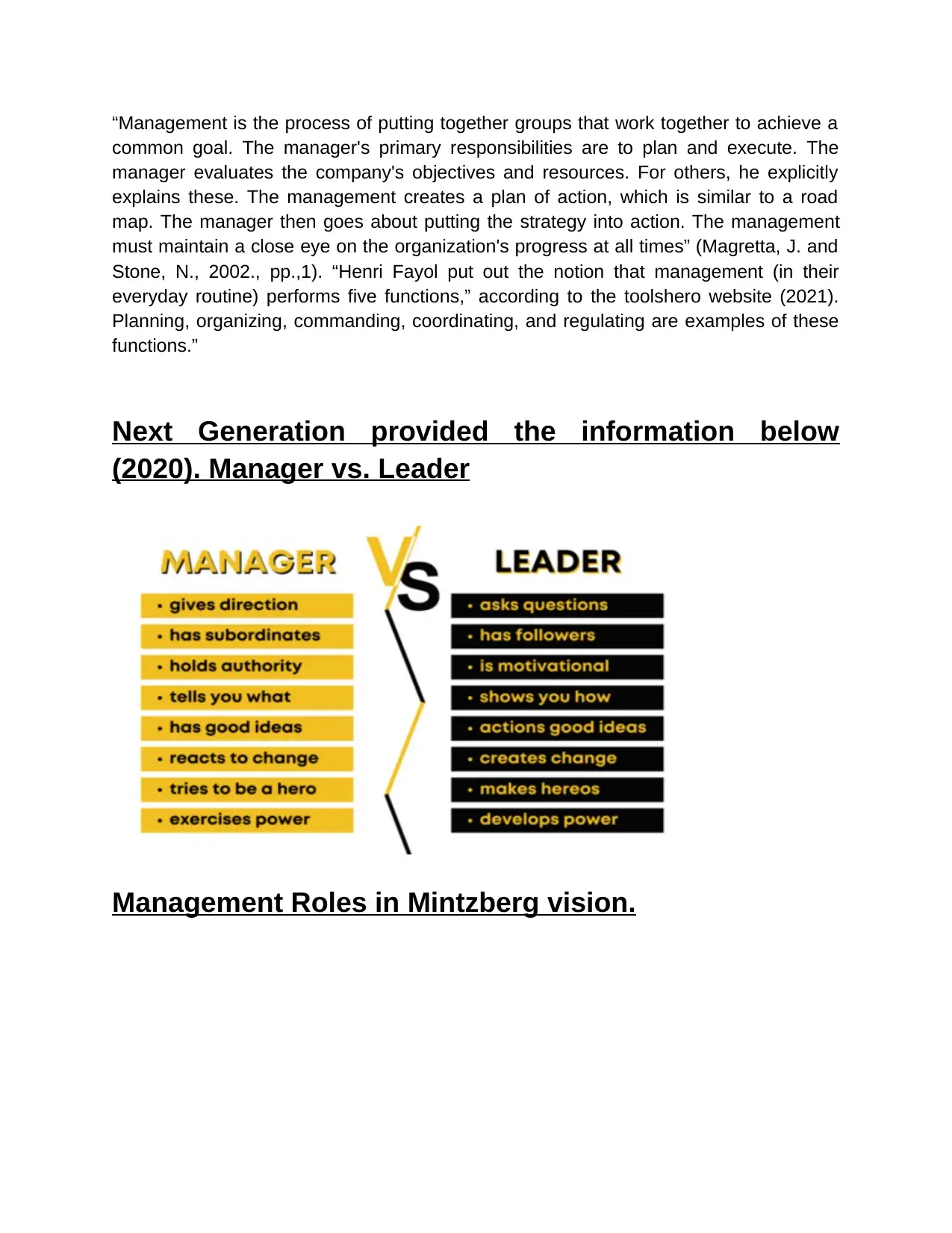
“Management is the process of putting together groups that work together to achieve a
common goal. The manager's primary responsibilities are to plan and execute. The
manager evaluates the company's objectives and resources. For others, he explicitly
explains these. The management creates a plan of action, which is similar to a road
map. The manager then goes about putting the strategy into action. The management
must maintain a close eye on the organization's progress at all times” (Magretta, J. and
Stone, N., 2002., pp.,1). “Henri Fayol put out the notion that management (in their
everyday routine) performs five functions,” according to the toolshero website (2021).
Planning, organizing, commanding, coordinating, and regulating are examples of these
functions.”
Next Generation provided the information below
(2020). Manager vs. Leader
Management Roles in Mintzberg vision.
common goal. The manager's primary responsibilities are to plan and execute. The
manager evaluates the company's objectives and resources. For others, he explicitly
explains these. The management creates a plan of action, which is similar to a road
map. The manager then goes about putting the strategy into action. The management
must maintain a close eye on the organization's progress at all times” (Magretta, J. and
Stone, N., 2002., pp.,1). “Henri Fayol put out the notion that management (in their
everyday routine) performs five functions,” according to the toolshero website (2021).
Planning, organizing, commanding, coordinating, and regulating are examples of these
functions.”
Next Generation provided the information below
(2020). Manager vs. Leader
Management Roles in Mintzberg vision.
Paraphrase This Document
Need a fresh take? Get an instant paraphrase of this document with our AI Paraphraser
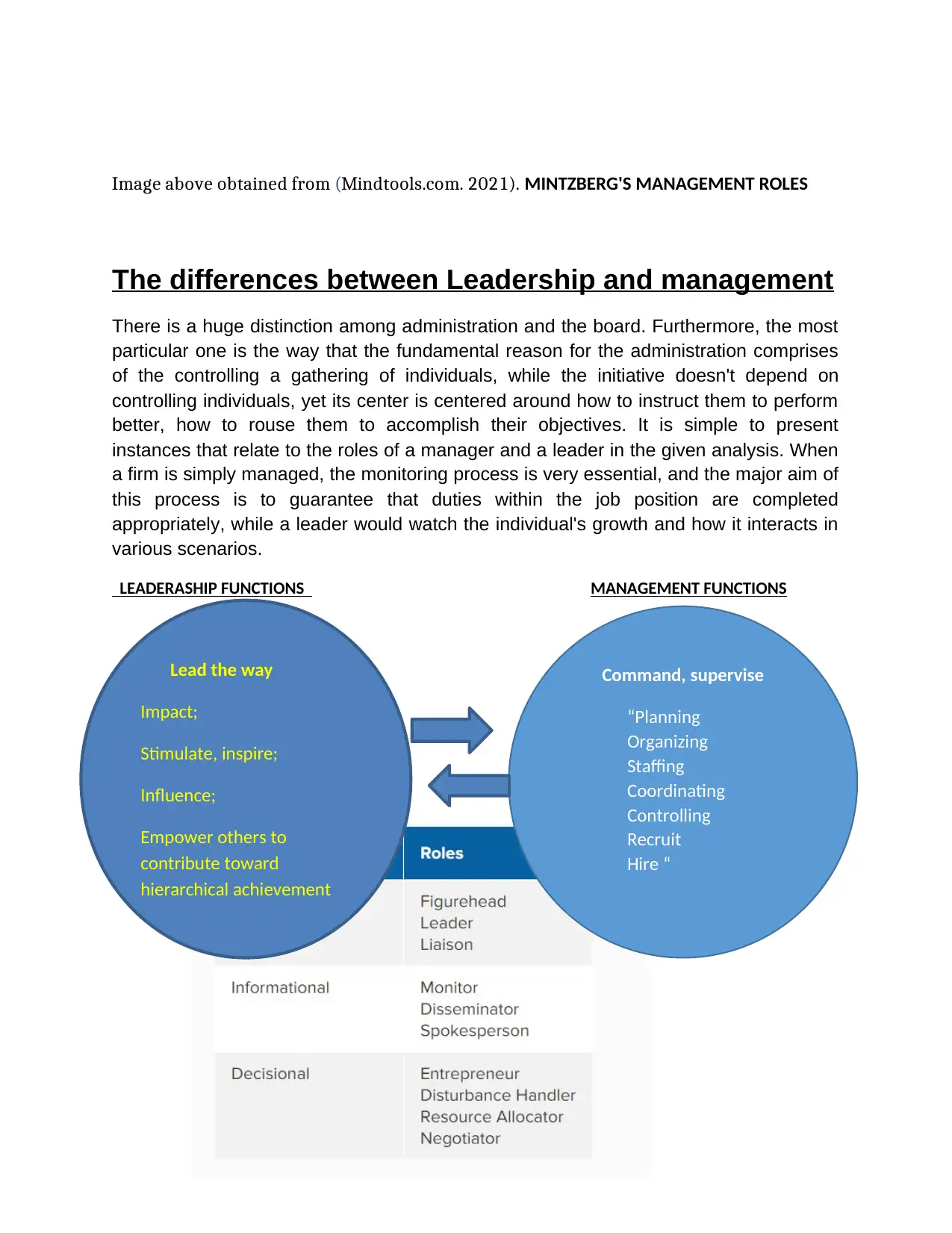
Image above obtained from (Mindtools.com. 2021). MINTZBERG'S MANAGEMENT ROLES
The differences between Leadership and management
There is a huge distinction among administration and the board. Furthermore, the most
particular one is the way that the fundamental reason for the administration comprises
of the controlling a gathering of individuals, while the initiative doesn't depend on
controlling individuals, yet its center is centered around how to instruct them to perform
better, how to rouse them to accomplish their objectives. It is simple to present
instances that relate to the roles of a manager and a leader in the given analysis. When
a firm is simply managed, the monitoring process is very essential, and the major aim of
this process is to guarantee that duties within the job position are completed
appropriately, while a leader would watch the individual's growth and how it interacts in
various scenarios.
LEADERASHIP FUNCTIONS MANAGEMENT FUNCTIONS
Organizing
Lead the way
Impact;
Stimulate, inspire;
Influence;
Empower others to
contribute toward
hierarchical achievement
Command, supervise
“Planning
Organizing
Staffing
Coordinating
Controlling
Recruit
Hire “
The differences between Leadership and management
There is a huge distinction among administration and the board. Furthermore, the most
particular one is the way that the fundamental reason for the administration comprises
of the controlling a gathering of individuals, while the initiative doesn't depend on
controlling individuals, yet its center is centered around how to instruct them to perform
better, how to rouse them to accomplish their objectives. It is simple to present
instances that relate to the roles of a manager and a leader in the given analysis. When
a firm is simply managed, the monitoring process is very essential, and the major aim of
this process is to guarantee that duties within the job position are completed
appropriately, while a leader would watch the individual's growth and how it interacts in
various scenarios.
LEADERASHIP FUNCTIONS MANAGEMENT FUNCTIONS
Organizing
Lead the way
Impact;
Stimulate, inspire;
Influence;
Empower others to
contribute toward
hierarchical achievement
Command, supervise
“Planning
Organizing
Staffing
Coordinating
Controlling
Recruit
Hire “
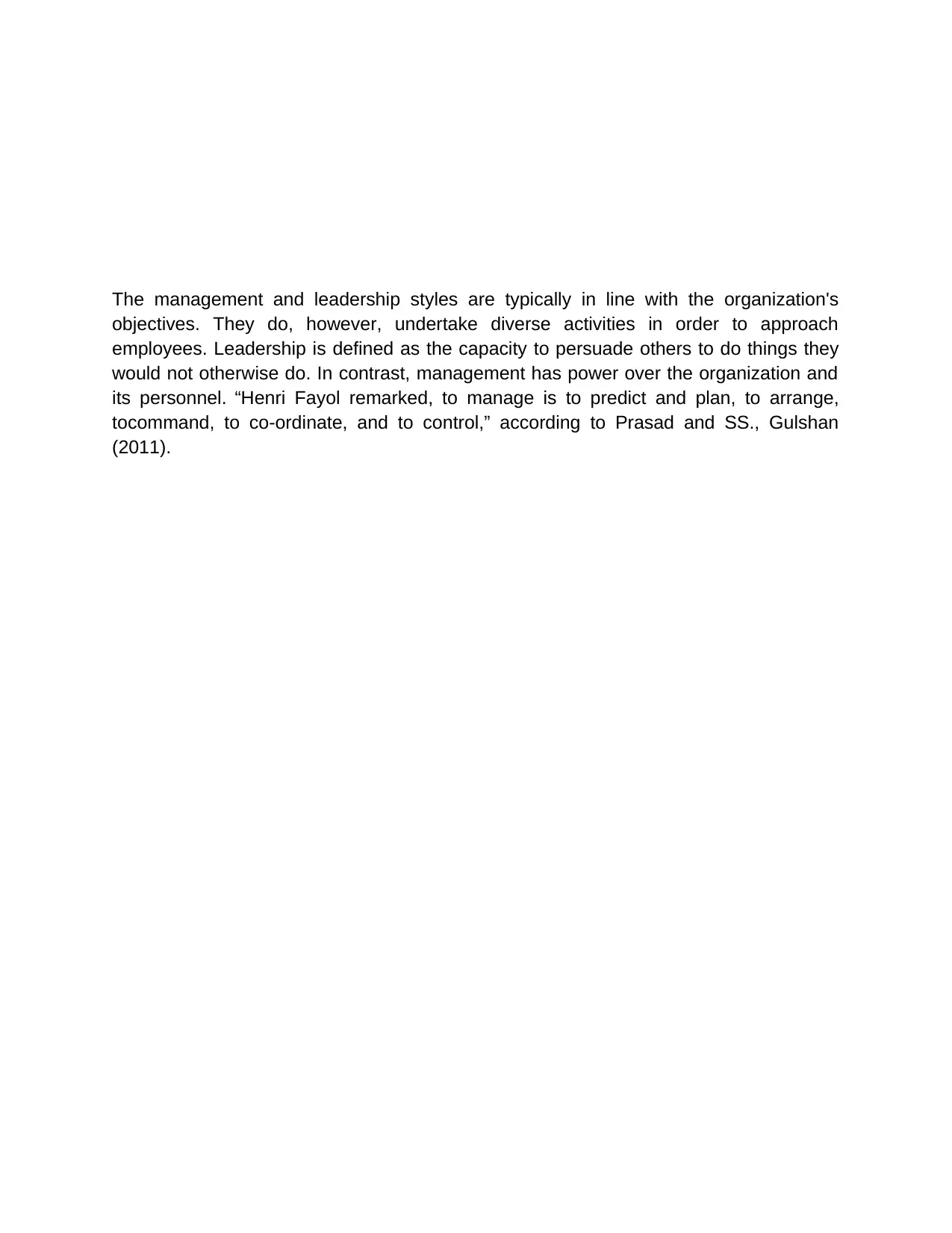
The management and leadership styles are typically in line with the organization's
objectives. They do, however, undertake diverse activities in order to approach
employees. Leadership is defined as the capacity to persuade others to do things they
would not otherwise do. In contrast, management has power over the organization and
its personnel. “Henri Fayol remarked, to manage is to predict and plan, to arrange,
tocommand, to co-ordinate, and to control,” according to Prasad and SS., Gulshan
(2011).
objectives. They do, however, undertake diverse activities in order to approach
employees. Leadership is defined as the capacity to persuade others to do things they
would not otherwise do. In contrast, management has power over the organization and
its personnel. “Henri Fayol remarked, to manage is to predict and plan, to arrange,
tocommand, to co-ordinate, and to control,” according to Prasad and SS., Gulshan
(2011).
⊘ This is a preview!⊘
Do you want full access?
Subscribe today to unlock all pages.

Trusted by 1+ million students worldwide
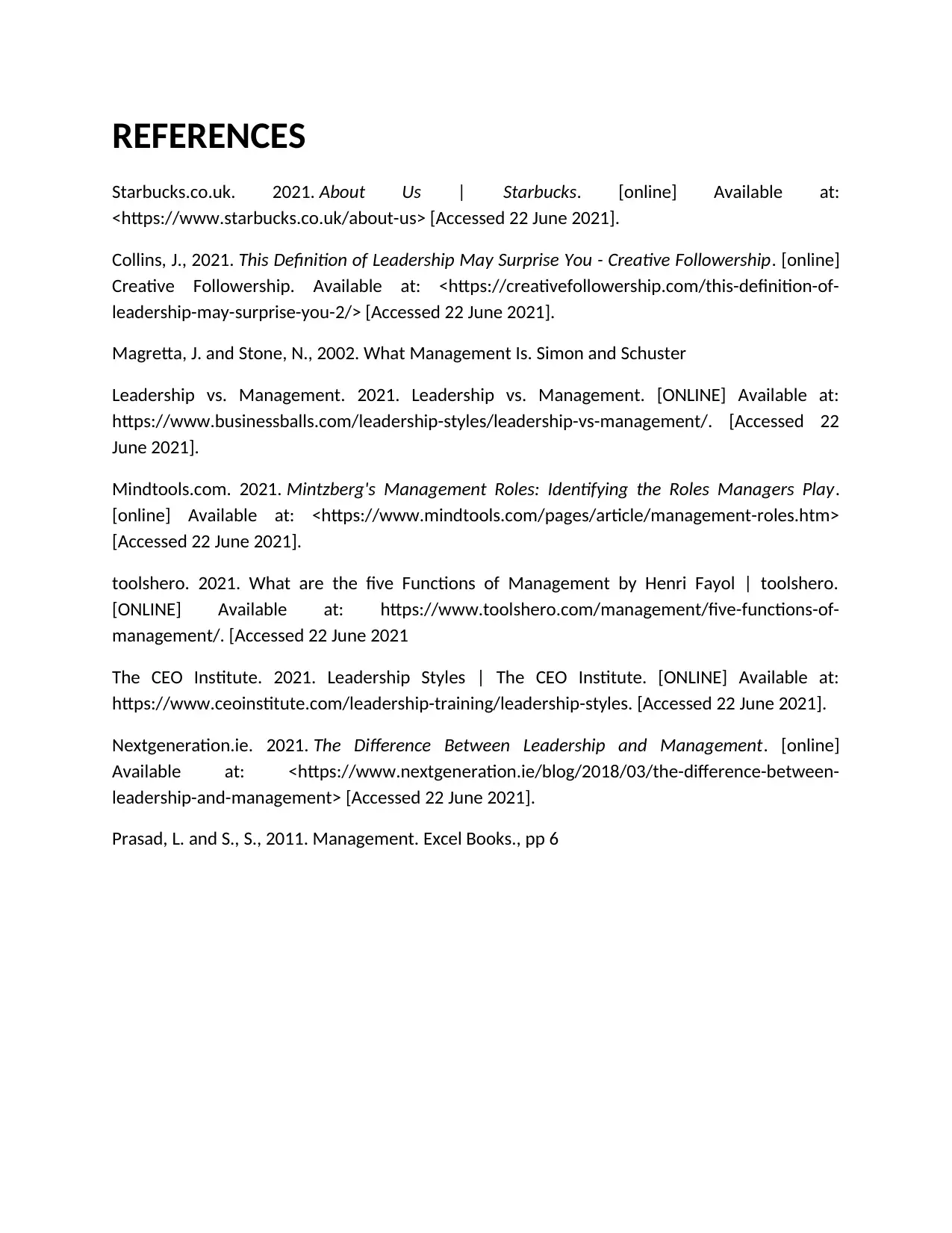
REFERENCES
Starbucks.co.uk. 2021. About Us | Starbucks. [online] Available at:
<https://www.starbucks.co.uk/about-us> [Accessed 22 June 2021].
Collins, J., 2021. This Definition of Leadership May Surprise You - Creative Followership. [online]
Creative Followership. Available at: <https://creativefollowership.com/this-definition-of-
leadership-may-surprise-you-2/> [Accessed 22 June 2021].
Magretta, J. and Stone, N., 2002. What Management Is. Simon and Schuster
Leadership vs. Management. 2021. Leadership vs. Management. [ONLINE] Available at:
https://www.businessballs.com/leadership-styles/leadership-vs-management/. [Accessed 22
June 2021].
Mindtools.com. 2021. Mintzberg's Management Roles: Identifying the Roles Managers Play.
[online] Available at: <https://www.mindtools.com/pages/article/management-roles.htm>
[Accessed 22 June 2021].
toolshero. 2021. What are the five Functions of Management by Henri Fayol | toolshero.
[ONLINE] Available at: https://www.toolshero.com/management/five-functions-of-
management/. [Accessed 22 June 2021
The CEO Institute. 2021. Leadership Styles | The CEO Institute. [ONLINE] Available at:
https://www.ceoinstitute.com/leadership-training/leadership-styles. [Accessed 22 June 2021].
Nextgeneration.ie. 2021. The Difference Between Leadership and Management. [online]
Available at: <https://www.nextgeneration.ie/blog/2018/03/the-difference-between-
leadership-and-management> [Accessed 22 June 2021].
Prasad, L. and S., S., 2011. Management. Excel Books., pp 6
Starbucks.co.uk. 2021. About Us | Starbucks. [online] Available at:
<https://www.starbucks.co.uk/about-us> [Accessed 22 June 2021].
Collins, J., 2021. This Definition of Leadership May Surprise You - Creative Followership. [online]
Creative Followership. Available at: <https://creativefollowership.com/this-definition-of-
leadership-may-surprise-you-2/> [Accessed 22 June 2021].
Magretta, J. and Stone, N., 2002. What Management Is. Simon and Schuster
Leadership vs. Management. 2021. Leadership vs. Management. [ONLINE] Available at:
https://www.businessballs.com/leadership-styles/leadership-vs-management/. [Accessed 22
June 2021].
Mindtools.com. 2021. Mintzberg's Management Roles: Identifying the Roles Managers Play.
[online] Available at: <https://www.mindtools.com/pages/article/management-roles.htm>
[Accessed 22 June 2021].
toolshero. 2021. What are the five Functions of Management by Henri Fayol | toolshero.
[ONLINE] Available at: https://www.toolshero.com/management/five-functions-of-
management/. [Accessed 22 June 2021
The CEO Institute. 2021. Leadership Styles | The CEO Institute. [ONLINE] Available at:
https://www.ceoinstitute.com/leadership-training/leadership-styles. [Accessed 22 June 2021].
Nextgeneration.ie. 2021. The Difference Between Leadership and Management. [online]
Available at: <https://www.nextgeneration.ie/blog/2018/03/the-difference-between-
leadership-and-management> [Accessed 22 June 2021].
Prasad, L. and S., S., 2011. Management. Excel Books., pp 6
1 out of 7
Related Documents
Your All-in-One AI-Powered Toolkit for Academic Success.
+13062052269
info@desklib.com
Available 24*7 on WhatsApp / Email
![[object Object]](/_next/static/media/star-bottom.7253800d.svg)
Unlock your academic potential
Copyright © 2020–2025 A2Z Services. All Rights Reserved. Developed and managed by ZUCOL.





